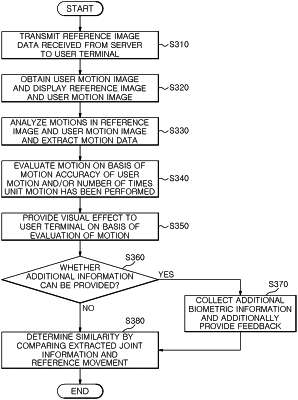| CPC G06T 7/248 (2017.01) [G06V 20/46 (2022.01); G06V 40/20 (2022.01)] | 15 Claims |

|
1. A motion recognition-based interaction method, comprising:
providing a first motion image as a reference to a user terminal;
obtaining a second motion image of a motion of a user from the user terminal;
extracting a reference movement from the first motion image, extracting a user movement from the second motion image;
correcting a movement vector of a subject of the reference movement by comparing relative coordinates of the subject of the reference movement with relative coordinates of a subject of the user movement so that an error caused by a difference in physical size between the subject of the reference movement and the subject of the user movement is corrected;
determining motion accuracy by comparing the corrected movement vector of the subject of the reference movement with a movement vector of the subject of the user movement;
evaluating a motion state of the user by comparing the reference movement with the user movement;
providing feedback to the user based on the evaluation of the motion state, wherein the feedback includes visual feedback,
wherein a plurality of users are grouped into one or more groups and the providing the first motion image further comprises providing the first motion image to the one or more groups;
receiving image reception delay information of the second motion image received by a plurality of user terminals;
applying a delay to remaining user terminals based on the user terminal having slowest image synchronization and synchronizing image synchronization; and
comparing motion images of the plurality of users belonging to the one or more groups with other users' second motion images.
|